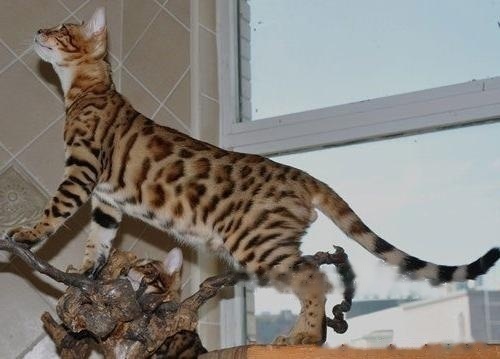The leopard cat is relatively rare in our life, which is also due to the sharp decrease in the number of leopard cats caused by human hunting. It has been listed as one of the world's rare animals internationally, but the leopard cat and other Maoye have the same experience After breeding and domestication, it is also an ornamental animal, but we can't raise leopard cats like ordinary cats, so before raising leopard cats, we must first understand the breeding methods and some living habits of leopard cats.

Living habits
Habitat: Ocelots mainly inhabit mountain forests and countryside shrubs Near Helinyuan Village. The distribution of altitudes can be distributed from low-altitude coastal zones to 3000m above sea level mountain forest areas. The largest number is in the semi-open sparse shrub habitat, dense virgin forests, cultivated artificial forests (such as rubber forests, tea forests, etc.) and open plain farmland are less in number, and there are few arid deserts and dunes.
Diet: mainly rodents, squirrels, flying squirrels, rabbits, frogs, lizards, snakes, It feeds on small birds and insects, and also eats berries, banyan fruit, and some tender leaves and grasses, and sometimes sneaks into the village to steal poultry such as chickens and ducks.
Habits: The dens are mostly in tree holes, soil holes, under stones or in stone crevices. The size of the leopard cat's nest area, the leopard cat is mainly ground dwelling, but has a strong climbing ability and is agile and free in the trees. Nocturnal, more active in the morning and evening. Solitary or in pairs. It is good at swimming, and likes to move and forage in places near water such as ponds, streams and ditches, and rice fields.
Population: The leopard cat is widely distributed in China and has a large number of resources. It is one of China's traditional foreign trade export furs. From the 1960s to the 1970s, the annual purchase of leopard cat fur in China was about 200,000 to 250,000 pieces, and it was estimated that the national leopard cat resource was no less than 1 million; East China) leopard cat has almost become an endangered species; after 80 years, the annual purchase volume is about 1/2-1/3 of that in the 1960s. Lu Houji and others have counted the number of acquisitions in the six southern provinces (Yunnan, Guizhou, Guangxi, Hunan, Hubei, Jiangxi) from 1955 to 1981. In the mid-1960s, the annual acquisitions in the six provinces in 1964 and 1965 were 22.2 and 172,000; 126,000 and 141,000 in 1978 and 1979, respectively. In the mid-1980s, the annual acquisition of leopard cat skins in China remained at around 150,000-200,000. From 1989 to 1990, there were more than 800,000 leopard cat skins in stock in China.
1. Breeding method
Leopard cats should be kept in pens alone or in pairs.
![[Dog Training 5] The training method of pet dog dining etiquette](/static/img/12192/12192_1.jpg)




